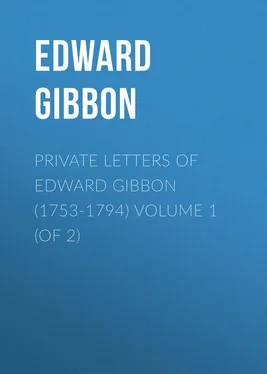Edward Gibbon - Private Letters of Edward Gibbon (1753-1794) Volume 1 (of 2)
Здесь есть возможность читать онлайн «Edward Gibbon - Private Letters of Edward Gibbon (1753-1794) Volume 1 (of 2)» — ознакомительный отрывок электронной книги совершенно бесплатно, а после прочтения отрывка купить полную версию. В некоторых случаях можно слушать аудио, скачать через торрент в формате fb2 и присутствует краткое содержание. Жанр: foreign_antique, foreign_prose, на английском языке. Описание произведения, (предисловие) а так же отзывы посетителей доступны на портале библиотеки ЛибКат.
- Название:Private Letters of Edward Gibbon (1753-1794) Volume 1 (of 2)
- Автор:
- Жанр:
- Год:неизвестен
- ISBN:нет данных
- Рейтинг книги:3 / 5. Голосов: 1
-
Избранное:Добавить в избранное
- Отзывы:
-
Ваша оценка:
- 60
- 1
- 2
- 3
- 4
- 5
Private Letters of Edward Gibbon (1753-1794) Volume 1 (of 2): краткое содержание, описание и аннотация
Предлагаем к чтению аннотацию, описание, краткое содержание или предисловие (зависит от того, что написал сам автор книги «Private Letters of Edward Gibbon (1753-1794) Volume 1 (of 2)»). Если вы не нашли необходимую информацию о книге — напишите в комментариях, мы постараемся отыскать её.
Private Letters of Edward Gibbon (1753-1794) Volume 1 (of 2) — читать онлайн ознакомительный отрывок
Ниже представлен текст книги, разбитый по страницам. Система сохранения места последней прочитанной страницы, позволяет с удобством читать онлайн бесплатно книгу «Private Letters of Edward Gibbon (1753-1794) Volume 1 (of 2)», без необходимости каждый раз заново искать на чём Вы остановились. Поставьте закладку, и сможете в любой момент перейти на страницу, на которой закончили чтение.
Интервал:
Закладка:
Footnote_6_6
Miss Hester Gibbon died unmarried in 1790, at the age of eighty-six, at King's Cliffe in Northamptonshire. William Law, the author of the Serious Call , originally her brother's tutor at Putney, afterwards her almoner, spiritual adviser and guide, died at her house in 1761. In the tomb which she caused to be built for him, she was also herself buried. Hester Gibbon is stated to have been the Miranda of the Serious Call ; but her age at the date when the book was published (1728) makes this doubtful.
Footnote_7_7
The second daughter of Mr. James Porten married Mr. Darrel of Richmond, and left two sons, Edward and Robert.
Footnote_8_8
Gibbon's father married his second wife, Miss Dorothea Patton, in 1755.
Footnote_9_9
David Mallet, or Malloch, poet, playwright, and miscellaneous writer (1705-65), is best known for his ballad of William and Margaret , his unsubstantiated claim to the authorship of Rule Britannia , and his edition of Bolingbroke's works. Bolingbroke, said Dr. Johnson, had "spent his life in charging a gun against Christianity," and "left half-a-crown to a hungry Scotchman to draw the trigger." Mallet was "a great declaimer in all the London coffee-houses against Christianity," and the obtrusion of his sceptical views made his household unpleasing to David Hume. To his house Gibbon was taken after his reception into the Church of Rome.
Footnote_10_10
A well-known doctor of the day.
Footnote_11_11
George Simon (1736-1809), Viscount Nuneham, afterwards second Earl of Harcourt, eldest son of the first earl. He was remarkable for his affectation of French manners and fashions.
Footnote_12_12
Word omitted in original.
Footnote_13_13
The Seven Years' War, 1756-63. – "A war," says Horace Walpole, "that reaches from Muscovy to Alsace and from Madras to California" (Horace Walpole to the Earl of Strafford, June 12, 1759).
Footnote_14_14
Dr. John Turton (1736-1806) was in 1782 appointed physician to both the King and Queen. He attended Goldsmith on his death-bed. His progress to fame and fortune was very rapid, and when he died he left his widow £9000 a year in land, and £60,000 in the funds. "The bulk of his great fortune he has bequeathed, after the death of his wife, to her Royal Highness the Princess Mary, their Majesty's fourth daughter" ( Annual Register , April 15, 1806).
Footnote_15_15
Miss Porten had now removed from College Street to a large boarding-house which she had built in Dean's Yard, Westminster.
Footnote_16_16
The lottery began to be drawn November 14, 1758; the last ticket was drawn December 12, when "No. 72,570 in the present lottery was drawn a prize of £10,000."
Footnote_17_17
Matthew Maty, born near Utrecht in 1718, settled in England as a physician in 1741; in 1756 he was appointed an under-librarian at the British Museum, and in 1772 succeeded Gowin Knight as chief librarian. His Journal Britannique (1750-55), published in French at the Hague, contains a bi-monthly review of English literature. He died in 1776. If the son, whom Gibbon "tipped," resembled the father, this passage may confirm Dr. Johnson's description of Maty as a "little black dog." For Gibbon's relations with Maty, see note to Letter 15.
Footnote_18_18
Dorothea Mallet, Madame Celesia (1738-1790), a poet and dramatist, eldest daughter, by his first wife, of David Mallet. She married Pietro Paolo Celesia, a Genoese gentleman, who was ambassador to this country from 1755 to 1759, and was afterwards ambassador to Spain. Madame Celesia's drama of Almida , an adaptation of Voltaire's Tancrède , was brought out at Drury Lane in 1771, and published in the same year.
Footnote_19_19
Dodsley's tragedy of Cleone was then being played at Covent Garden.
Footnote_20_20
Sir William Milner, Bart. (1719-1774), for many years receiver-general of the Excise, married Elizabeth, youngest daughter of the Hon. and Rev. George Mordaunt, brother of the third Earl of Peterborough. She died a year after her husband.
Footnote_21_21
Sir John Brute, the surly, drunken husband of Lady Brute in Vanbrugh's play of The Provoked Wife .
Footnote_22_22
Mallet's tragedy Eurydice , written in 1731, was revived in 1759. The Smyrna Coffee-house in Pall Mall stood on the site now occupied by Messrs. Harrison, the booksellers. It was famous in the days of the Tatler and the Spectator .
Footnote_23_23
On his return from Lausanne Gibbon completed his Essai sur l'étude de la Littérature , his first published work. The manuscript was submitted to Dr. Maty in 1758, and by his advice partly rewritten and wholly revised. It was published in French, with a letter to the author from Dr. Maty, in 1761. The essay is printed in The Miscellaneous Works of Edward Gibbon (ed. 1814), vol. iv. pp. 1-93.
Footnote_24_24
Lady Hervey, the beautiful "Molly Lepel," daughter of Brigadier-General Nicholas Lepel, was the widow of John, Lord Hervey, the "Sporus" of Pope's Prologue to the Satires , and the Boswell of George II. and Queen Caroline. Married in October, 1720, she was the mother of four sons, three of whom in succession became Earl of Bristol. She died September 2, 1768.
Footnote_25_25
In June, 1759, Gibbon and his father joined the Hampshire regiment of militia as respectively captain and major. The South battalion, to which they belonged, was kept "under arms, in constant pay and duty," from the date of its enrolment till December 23, 1762, when it was disbanded as a permanent force. The battalion was at Winchester Camp from June 25 to October 23, 1761, and from the latter date to February 28, 1762, at "the populous and disorderly town of Devizes" (see next letter). His Autobiography shows that Gibbon found that "a camp," as Johnson wrote to Mrs. Thrale in October, 1778, "however familiarly we may speak of it, is one of the great scenes of human life," and that, partially at least, he agreed with Lord Chesterfield, that "courts and camps are the only places to learn the world in."
Footnote_26_26
The Black Musqueteers of Colonel Barré were raised in 1761-2 as the 106th Regiment of Foot (or Black Musqueteers.) See List of General and Field Officers for 1763, p. 175.
Footnote_27_27
William, Lord Fitzmaurice, M.P. for Chipping Wycombe, afterwards Prime Minister (1782), and first Marquess of Lansdowne, succeeded his father as second Earl of Shelburne in the spring of 1761. He acted as the go-between in the negotiations between Bute and Fox, which led to the cessation of the Seven Years' War and the Treaty of Paris.
Footnote_28_28
Robert Sharrock was a captain in the South Battalion of the Hampshire Militia.
Footnote_29_29
James Hall received his commission as ensign in February, 1762.
Footnote_30_30
John Butler Harrison, lieutenant in the South Battalion, was Gibbon's chief friend in the regiment. In his journal Gibbon speaks of the disagreeable society in which he was compelled to live. "No manners, no conversation, they were only a set of fellows, all whose behaviour was low, and most of whose characters were despicable. I must, however, except Sir Thomas and Harrison out of this society. Harrison is a young man of honour, spirit, and good nature. The virtues of his heart make amends for his having none of the head."
Читать дальшеИнтервал:
Закладка:
Похожие книги на «Private Letters of Edward Gibbon (1753-1794) Volume 1 (of 2)»
Представляем Вашему вниманию похожие книги на «Private Letters of Edward Gibbon (1753-1794) Volume 1 (of 2)» списком для выбора. Мы отобрали схожую по названию и смыслу литературу в надежде предоставить читателям больше вариантов отыскать новые, интересные, ещё непрочитанные произведения.
Обсуждение, отзывы о книге «Private Letters of Edward Gibbon (1753-1794) Volume 1 (of 2)» и просто собственные мнения читателей. Оставьте ваши комментарии, напишите, что Вы думаете о произведении, его смысле или главных героях. Укажите что конкретно понравилось, а что нет, и почему Вы так считаете.












